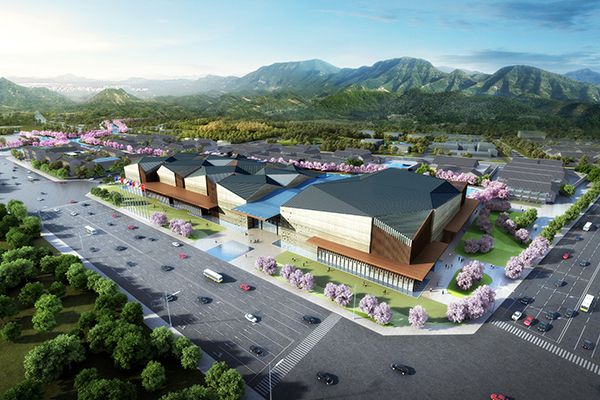
International Exhibition Center of Jinhai Lake
Geography and administrative division of Pinggu. Pinggu is located in the northeast of Beijing and lies in the junction of Beijing, Tianjin and Hebei, making it an important area and core belt for Beijing-Tianjin-Hebei coordinated development. The district got its name "Pinggu (meaning plain valley floor in Chinese)" as it is a plain valley floor surrounded by mountains from three sides. The district covers a total area of 960 square kilometers areas each occupying a third of the district. Pinggu's geography can be featured as "meters, with mountainous areas, shallow mountainous areas and plaione mountain, two rivers and a delta area", namely, the two mother rivers of Pinggu, Juhe River and Ruhe River and the alluvial delta plain as a result. The district incorporates 2 subdistricts, 16 townships, 273 administrative villages and 24 community resident committees. There are 456,000 permanent residents (including 51,000 non-native residents) in the district.
Pinggu enjoys great traffic conditions. Pinggu is 45 kilometers east from Beijing Capital International Airport, 70 kilometers from Beijing downtown, 40 kilometers from Beijing's sub-center Tongzhou, and 110 kilometers northwest to Tianjin downtown, 130 kilometers from Tianjin New Port, 100 kilometers from Tangshan downtown and 220 kilometers from Qinghuangdao Port. Moreover, the Beijing-Pinggu Expressway spans the whole district, and Mafang feeder railway of its local railway connects with Datong-Qinghuangdao Railway, creating a convenient condition for cargo transport. Besides, the Beijing-Pinggu logistic hub is being planned vigorously, while Beijing Subway Line 22 (Pinggu Line) and Chengde-Pinggu Expressway project will soon be launched.
Pinggu has a lot to offer. Pinggu is the first national forest urban area in Beijing. Over the years, it has won numerous recognitions including "famous tourism district with the highest international influence", "major district for eco-tourism in China", "top hundred eco-environment district in China", "model district for leisure agriculture and rural tourism in China", "national hygienic district" and "model district for leisure tourism in east Beijing". Meanwhile, the district enjoys a number of titles such as "Home of Chinese Calligraphy", "Home of Big Peach in China" and "Home of Ornamental Stone in China". As the "national peach", the Pinggu big peach is a "gilded name card" for Pinggu. Moreover, Pinggu owns the largest peach orchard in the world.
Pinggu enjoys profound history and culture. Pinggu boasts seven-thousand-year Shangzhai Culture and is known as "the forefather of Hongshan Culture". Moreover, Pinggu has five-thousand-year Xuanyuan Culture, three-thousand-year Bronze Culture, two-thousand-two-hundred-year Establishment Culture and millennium Daoism Culture. There are two holy mountains for Daoism Culture in Beijing. As the saying goes, "In the west, there is Miaofeng Mountain, and in the east, there is Yaji Mountain", and the Yaji Mountain is right in Pinggu District. Furthermore, Pinggu takes pride in its 600 years of Great Wall Culture and its unique Gold Mining Culture in Beijing. It is praised as "a district with tens of thousands of liang (an ancient unit of weight, 37.30 grams from Tang to Qing Dynasty, yet varies in previous ones) of Gold". Thus, there is no doubt that Pinggu boasts profound history and culture.
Pinggu is endowed with sound eco-environment. Pinggu's forest coverage rate is up to 67.94 percent, ranking first in Beijing. Moreover, the district is abundant in water resources as Juhe River and Ruhe River, both belonging to Jiyun River system, run through the entire Pinggu. In total, the annual water resources aggregation stands at 225 million cubic meters. In 2019, Pinggu's PM2.5 concentration index was 40μg/m3 and its water quality of surface water section is both stable and up to par. Moreover, the Jinhai Lake, with the largest water body and the only one available for entertainment purpose, maintained second-class water quality for three years in a row. At the same time, Pinggu's environment-related data and index of all categories are relatively sound in Beijing. Furthermore, Pinggu is already famous for its beautiful countryside views, wonderful idyllic scenery and gorgeous Pinggu landscape, making it one of the first districts to be listed as a demonstration area for all-for-one tourism in China.
Pinggu has a clear-cut industry development path. Pinggu follows a major path of "relying on ecology and achieving green development", namely, pursuing high-quality development. As per the district's planning 2035, Pinggu's function designation will be featured as "Three Areas and One Port", namely, Coordination Area for East Beijing Major Eco-Conservation and Regional Eco-Governance, Demonstration Area for Featured Leisure and Green Economy Innovation and Development, Demonstration Area for Agriculture Science Innovation and Comprehensive Logistics Port for Beijing. In addition, Pinggu will give priority to three major fields such technology innovation in agriculture, green and smart logistics and UAV, and prioritize a number of industries including leisure tourism, biomedicine, intelligent manufacturing, IT and bio-seed.
Pinggu enjoys rather abundant room for development. Zhongguancun Pinggu Park covers a total area of 5.08 square kilometers, covering Xinggu Economic Development Zone, Mafang Industrial Park, Mafang Logistics Base and Yukou Town, making Pinggu an essential district for the implementation of major projects. Over the years, Pinggu government has sorted out and made available 906.8 mu (a unit of area=0.0667 hectares) of industrial land and 153,600 square meters of idle plants. Moreover, Pinggu has nearly one million square meters of commercial buildings available for commercial real estate economy. Furthermore, there is a lot of collective agricultural construction land and idle homestead available for development and reuse.

